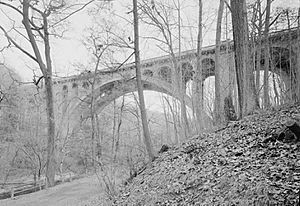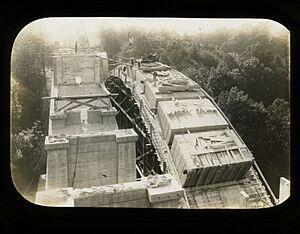Walnut Lane Bridge facts for kids
Quick facts for kids Walnut Lane Bridge |
|
|---|---|
 |
|
| Crosses | Wissahickon Creek |
| Locale | Philadelphia, Pennsylvania |
| Maintained by | City of Philadelphia |
| Characteristics | |
| Design | concrete |
| Total length | 585 feet (178 m) |
| Width | 48 feet (15 m) |
| Height | 147 feet (45 m) |
| Longest span | 233 feet (71 m) |
| History | |
| Construction cost | $260,000 ($5 Million Today) |
| Opened | October 14, 1908 |
|
Walnut Lane Bridge
|
|
| Location | Philadelphia, Pennsylvania United States |
| Built | 1907 |
| Architect | George S. Webster (chief) Henry H. Quimby (assistant) |
| NRHP reference No. | 88000815 |
| Significant dates | |
| Added to NRHP | May 10, 1988 |
The Walnut Lane Bridge is a special concrete arch bridge in Northwest Philadelphia. It connects the Germantown and Roxborough neighborhoods. This amazing bridge crosses the Wissahickon Creek in Fairmount Park.
Many artists and writers, like Christopher Morley, have been inspired by the view from under the bridge. Its design was even copied from the Pont Adolphe bridge in Luxembourg. In 1988, the Walnut Lane Bridge was added to the National Register of Historic Places. This means it's recognized as an important historical site.
Contents
Building the Bridge: How It Was Made
Construction of the Walnut Lane Bridge started on July 5, 1906. It was finished a little over two years later, on October 14, 1908. Workers poured over 40,000 tons of special concrete into the bridge's framework. This concrete had many large stones inside to make it extra strong.
The framework itself was built from steel supports and a huge amount of timber. The bridge has six sections, which together stretch 585 ft in length (178 m). Not much steel was used for reinforcement because it was hard to find back then. The road part of the bridge is 40 ft (12 m) wide. On each side, there are 10-foot (3.0 m) wide sidewalks made of reinforced concrete. There are also decorative concrete railings.
The main engineer for the project was George S. Webster. Henry Quimby was his assistant. Both worked for Philadelphia's Department of Public Works. When it was built, the Walnut Lane Bridge was the longest and highest concrete arch bridge anywhere in the world! The project cost about $260,000, which would be nearly $6 million today.
The City Beautiful Idea
The Walnut Lane Bridge was a big part of the "City Beautiful" movement in Philadelphia. This movement, popular in the early 1900s, aimed to make cities better places to live. People believed that beautiful public spaces could help communities work together.
The bridge was seen as a way to connect the neighborhoods of Roxborough and Germantown. It was also hoped that building beautiful structures would encourage people to be more involved in their city. The people of Philadelphia were very excited about the bridge's construction. Everyone, young and old, looked forward to its grand opening.
Grand Opening Celebration
The Walnut Lane Bridge officially opened on October 14, 1908. A special dedication ceremony was held on December 16 of the same year. Students from nearby schools took part in the celebration. They marched to the middle of the bridge and sang "Hail Philadelphia."
The ceremony ended with a party at a local inn. Guests enjoyed a traditional Wissahickon meal of catfish and waffles. It was a big day for the city!
Other Bridges: Don't Get Confused!
The Walnut Lane Bridge is sometimes mixed up with other bridges in Philadelphia. This is because they have similar names or designs.
- The Walnut Street Bridge crosses the Schuylkill River. It connects University City, Philadelphia and Center City, Philadelphia.
- The nearby Wissahickon Memorial Bridge (also called the Henry Avenue Bridge) is also often mistaken for the Walnut Lane Bridge. It connects the East Falls and Roxborough neighborhoods.
- The bridge most often confused with the Walnut Lane Bridge is the Walnut Lane Memorial Bridge. This bridge was built in 1950. It replaced an old cast-iron bridge over the Monoshone Creek. It is famous worldwide for being a special type of concrete bridge.
100th Birthday Celebration
In 2008, the Cliveden museum celebrated the bridge's 100th anniversary. Cliveden is a National Historic Landmark in Germantown, just a few blocks from the bridge.
Cliveden hosted a special exhibit and educational program about how the bridge was built. The exhibit featured a collection of rare old "lantern slides." These were like early photographic slides. The exhibit was open from May through October.


